Employee's Satisfaction at Work: An Empirical Study
71 Pages22854 Words163 Views
Added on 2019-12-18
About This Document
17 1.11 Significance of the research.18 CHAPTER 2: LITERATURE REVIEW 19 2.0: Literature Review.19 2.1: Definition of Key Concept.19 2.2 Theoretical gap 24 2.3.1 Maslow's need hierarchy theory.25 2.3.2 Herzberg (2014) two factor theory. The main purpose of this research is to investigate the impact of job satisfaction and job performance to ward organizational commitment.
Employee's Satisfaction at Work: An Empirical Study
Added on 2019-12-18
ShareRelated Documents
Dissertation
1
1
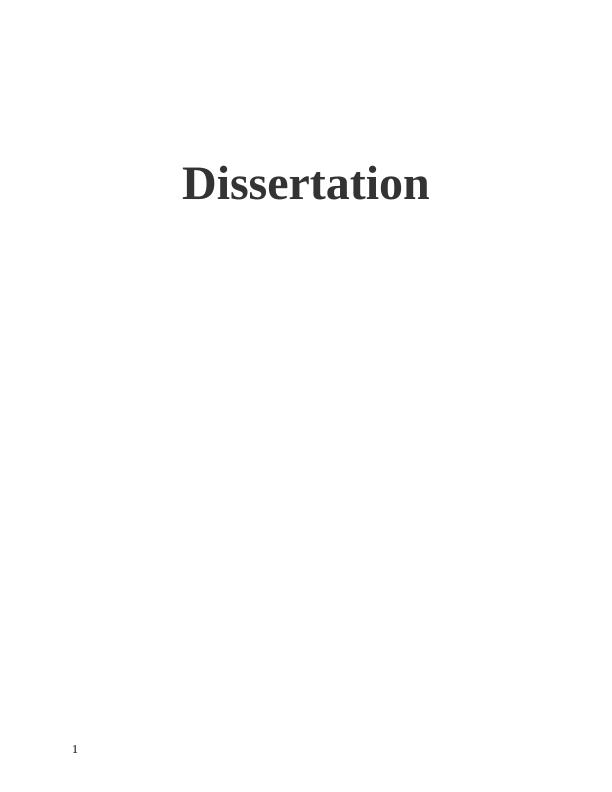
Table of Contents
1.1Imperial Studies on Employee’s Satisfaction.............................................................................5
1.2Imperial Studies on Employee’s Psychological Ownership.......................................................7
1.3.1Factors contributing to employee satisfaction at workplace.............................................10
..................................................................................................................................................10
1.4 Background.........................................................................................................................12
1.5 Rational...............................................................................................................................13
1.6 Aim and Objectives.............................................................................................................14
1.7 Research question................................................................................................................14
1.8 Focus and purpose...............................................................................................................15
1.9 Dissertation structure..........................................................................................................16
1.10 Framework and analysis....................................................................................................17
1.11 Significance of the research..............................................................................................18
CHAPTER 2: LITERATURE REVIEW.......................................................................................19
2.0: Literature Review...................................................................................................................19
2.1: Definition of Key Concept......................................................................................................19
2.2 Theoretical gap....................................................................................................................24
2.3.1 Maslow's need hierarchy theory.......................................................................................25
2.3.2 Herzberg two factor theory..............................................................................................26
2.4 The Concept of Work Performance....................................................................................27
2.5 Conceptual Framework.......................................................................................................29
2.6 Co-relationship between satisfaction level and employee performance.............................31
2.8 Dimensions of psychological ownership of employees......................................................37
2.9 Conclusion...........................................................................................................................39
CHAPTER 3: RESEARCH METHODOLOGY...........................................................................41
3.1 Introduction.........................................................................................................................41
3.2 Research philosophy...........................................................................................................41
3.3 Research design...................................................................................................................43
..................................................................................................................................................43
3.4 Research methodology........................................................................................................43
3.5 Data collection....................................................................................................................44
3.6 Sampling.............................................................................................................................45
3.7 Data analysis.......................................................................................................................46
3.8 Validity and reliability........................................................................................................46
3.9 Ethical considerations.........................................................................................................47
3.10 Research limitations..........................................................................................................48
3.11 Accessibility issues...........................................................................................................48
CHAPTER 4– DATA ANALYSIS...............................................................................................50
4.1 Introduction.........................................................................................................................50
4.2 Discussion...........................................................................................................................50
CHAPTER 5: CONCLUSION AND RECOMMENDATION.....................................................69
5.1 Conclusion...........................................................................................................................69
5.2 Recommendation.................................................................................................................71
REFERENCES..............................................................................................................................73
APPENDIX....................................................................................................................................79
2
1.1Imperial Studies on Employee’s Satisfaction.............................................................................5
1.2Imperial Studies on Employee’s Psychological Ownership.......................................................7
1.3.1Factors contributing to employee satisfaction at workplace.............................................10
..................................................................................................................................................10
1.4 Background.........................................................................................................................12
1.5 Rational...............................................................................................................................13
1.6 Aim and Objectives.............................................................................................................14
1.7 Research question................................................................................................................14
1.8 Focus and purpose...............................................................................................................15
1.9 Dissertation structure..........................................................................................................16
1.10 Framework and analysis....................................................................................................17
1.11 Significance of the research..............................................................................................18
CHAPTER 2: LITERATURE REVIEW.......................................................................................19
2.0: Literature Review...................................................................................................................19
2.1: Definition of Key Concept......................................................................................................19
2.2 Theoretical gap....................................................................................................................24
2.3.1 Maslow's need hierarchy theory.......................................................................................25
2.3.2 Herzberg two factor theory..............................................................................................26
2.4 The Concept of Work Performance....................................................................................27
2.5 Conceptual Framework.......................................................................................................29
2.6 Co-relationship between satisfaction level and employee performance.............................31
2.8 Dimensions of psychological ownership of employees......................................................37
2.9 Conclusion...........................................................................................................................39
CHAPTER 3: RESEARCH METHODOLOGY...........................................................................41
3.1 Introduction.........................................................................................................................41
3.2 Research philosophy...........................................................................................................41
3.3 Research design...................................................................................................................43
..................................................................................................................................................43
3.4 Research methodology........................................................................................................43
3.5 Data collection....................................................................................................................44
3.6 Sampling.............................................................................................................................45
3.7 Data analysis.......................................................................................................................46
3.8 Validity and reliability........................................................................................................46
3.9 Ethical considerations.........................................................................................................47
3.10 Research limitations..........................................................................................................48
3.11 Accessibility issues...........................................................................................................48
CHAPTER 4– DATA ANALYSIS...............................................................................................50
4.1 Introduction.........................................................................................................................50
4.2 Discussion...........................................................................................................................50
CHAPTER 5: CONCLUSION AND RECOMMENDATION.....................................................69
5.1 Conclusion...........................................................................................................................69
5.2 Recommendation.................................................................................................................71
REFERENCES..............................................................................................................................73
APPENDIX....................................................................................................................................79
2

Questionnaire............................................................................................................................79
3
3

1.0: Introduction
Ultimate aim of any organization is to gain maximum profit. With the initiation of globalization,
one of the major challenges for managers is to develop valuable strategies for human resource to
perk up business performance. Job satisfaction that describes how happy a person is with his /
her job. According to, a number of studies job satisfactions are a pleasurable or positive
emotional state resulting from the valuation of their work and experience (Jussila, Tarkiainen,
Sarstedt and Hair, 2015). Undefined optimistic attitude towards work and an enhanced
organizational commitment leads to greater job satisfaction which in return perks up the
performance of the individual.
The main purpose of this research is to investigate the impact of job satisfaction and job
performance to ward organizational commitment. And To highlight the effects of psychological
ownership on employee performance in Small and Medium Enterprises (SME's) in Kuala
Lumpur Malaysia.
Employees can be determined as one of the main and important resource within the firm. They
are the one who have direct interaction with customers. They present the products and services
that are being delivered by the firm. In this context, it is important to make sure that all the issues
that are being faced by employees are identified and solved so that they will be able to put on
their full efforts to make the organization achieve the goals and objectives. Workers involvement
and their interest towards the work is important that has to be considered so that they understand
that requirement and make improvement in their skills and capabilities so that perform better and
support the firm (Wong and Laschinger, 2013).
There are different departments and for each of them, there are employees who work together to
make sure that management will be able to achieve the organizational goals and objectives. One
of the issuers that affect the satisfaction level is conflicts. There are different type of reasons due
to which conflicts arises. This is one of the issues due to which performance of workers gets
negatively affected. However, it is important to make sure that there is proper interaction with
employees. This will enable to understand problems or issues that are being faced by them
(Ramos, Man and Ng, 2014). Further, interaction also enables to develop trust and confidence
4
Ultimate aim of any organization is to gain maximum profit. With the initiation of globalization,
one of the major challenges for managers is to develop valuable strategies for human resource to
perk up business performance. Job satisfaction that describes how happy a person is with his /
her job. According to, a number of studies job satisfactions are a pleasurable or positive
emotional state resulting from the valuation of their work and experience (Jussila, Tarkiainen,
Sarstedt and Hair, 2015). Undefined optimistic attitude towards work and an enhanced
organizational commitment leads to greater job satisfaction which in return perks up the
performance of the individual.
The main purpose of this research is to investigate the impact of job satisfaction and job
performance to ward organizational commitment. And To highlight the effects of psychological
ownership on employee performance in Small and Medium Enterprises (SME's) in Kuala
Lumpur Malaysia.
Employees can be determined as one of the main and important resource within the firm. They
are the one who have direct interaction with customers. They present the products and services
that are being delivered by the firm. In this context, it is important to make sure that all the issues
that are being faced by employees are identified and solved so that they will be able to put on
their full efforts to make the organization achieve the goals and objectives. Workers involvement
and their interest towards the work is important that has to be considered so that they understand
that requirement and make improvement in their skills and capabilities so that perform better and
support the firm (Wong and Laschinger, 2013).
There are different departments and for each of them, there are employees who work together to
make sure that management will be able to achieve the organizational goals and objectives. One
of the issuers that affect the satisfaction level is conflicts. There are different type of reasons due
to which conflicts arises. This is one of the issues due to which performance of workers gets
negatively affected. However, it is important to make sure that there is proper interaction with
employees. This will enable to understand problems or issues that are being faced by them
(Ramos, Man and Ng, 2014). Further, interaction also enables to develop trust and confidence
4
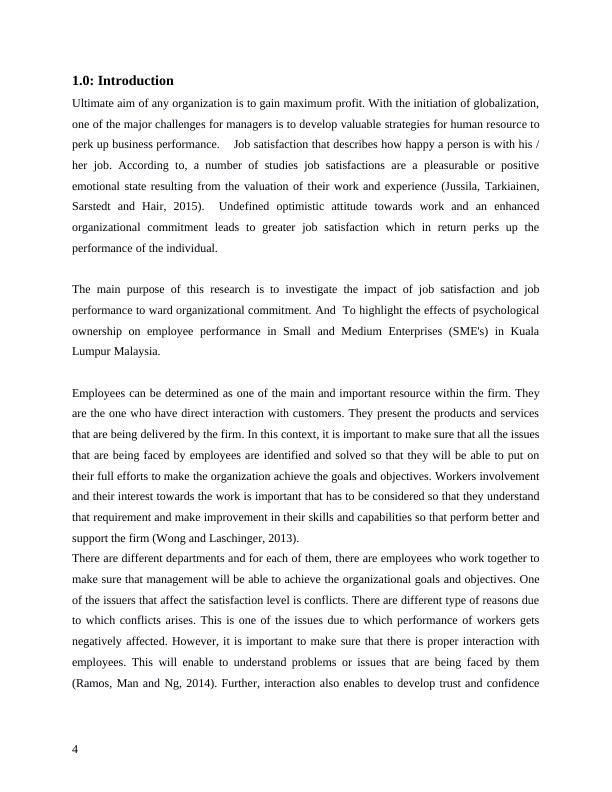
within the mind of people. This way it becomes helpful enough to reach out the areas in which
improvement is required to be achieved.
Imperial Studies on Employee’s Satisfaction
A number of studies had been done in relation to job satisfaction among the employees.
Optimized the performance of the employee are important so the route to achieved the end result
of generating greater income and optimized profit for the company will be more attainable, in
this section we going to highlight a number of the pioneer in this area.
Masooma Javed, et al (2014) focus to examine the satisfaction level of the employees and helps
organizations to know about the elements that influence job satisfaction. The authors utilized two
sections of variables in the research. Section 1 in the research mentioned on different personal
and demographic variables to attain the respondents’ information about gender, age, tenure,
income and education while Section 2 consists of the latent variables that include employee
empowerment, workplace environment, job performance, and turnover intention and job loyalty
towards job satisfaction (Mulki, Caemmerer and Heggde, 2015). The result shows that there are
significant positive associations of employee empowerment, workplace environment, job loyalty
and job performance with job satisfaction.
Hafiz Imran , et al (2014) intends to investigate the impact of job satisfaction and job
performance to ward organizational commitment. The authors adopted survey method to conduct
the research. There are five controlled variables i.e. Gender, Department, Education, Income and
Age in the research. In order to conduct the survey, dichotomous and interval scales were use to
measure the variables. The result of the search study is that the job performance of is strongly
associated with job satisfaction and these of two variables are coherent or in harmony.
Chung Jo Ey and Dr Rashad Yazdanifard (2014), the study discuss the factors that affect
employees' satisfaction and the impact of their satisfaction to the company's well-being and
sustainability of the company in the long run. The authors utilized the following variables i.e.
Corporate Culture, Pay Satisfaction, Management Style, Meaningfulness Of Work, Customer
Satisfaction Corporate Financial Performance, And Company’s Sustainability In The Long Run
in their studies in regards of job satisfaction among the employees' It has been verified in this
study that job satisfaction will directly affect employees' motivation and engagement in work and
5
improvement is required to be achieved.
Imperial Studies on Employee’s Satisfaction
A number of studies had been done in relation to job satisfaction among the employees.
Optimized the performance of the employee are important so the route to achieved the end result
of generating greater income and optimized profit for the company will be more attainable, in
this section we going to highlight a number of the pioneer in this area.
Masooma Javed, et al (2014) focus to examine the satisfaction level of the employees and helps
organizations to know about the elements that influence job satisfaction. The authors utilized two
sections of variables in the research. Section 1 in the research mentioned on different personal
and demographic variables to attain the respondents’ information about gender, age, tenure,
income and education while Section 2 consists of the latent variables that include employee
empowerment, workplace environment, job performance, and turnover intention and job loyalty
towards job satisfaction (Mulki, Caemmerer and Heggde, 2015). The result shows that there are
significant positive associations of employee empowerment, workplace environment, job loyalty
and job performance with job satisfaction.
Hafiz Imran , et al (2014) intends to investigate the impact of job satisfaction and job
performance to ward organizational commitment. The authors adopted survey method to conduct
the research. There are five controlled variables i.e. Gender, Department, Education, Income and
Age in the research. In order to conduct the survey, dichotomous and interval scales were use to
measure the variables. The result of the search study is that the job performance of is strongly
associated with job satisfaction and these of two variables are coherent or in harmony.
Chung Jo Ey and Dr Rashad Yazdanifard (2014), the study discuss the factors that affect
employees' satisfaction and the impact of their satisfaction to the company's well-being and
sustainability of the company in the long run. The authors utilized the following variables i.e.
Corporate Culture, Pay Satisfaction, Management Style, Meaningfulness Of Work, Customer
Satisfaction Corporate Financial Performance, And Company’s Sustainability In The Long Run
in their studies in regards of job satisfaction among the employees' It has been verified in this
study that job satisfaction will directly affect employees' motivation and engagement in work and
5
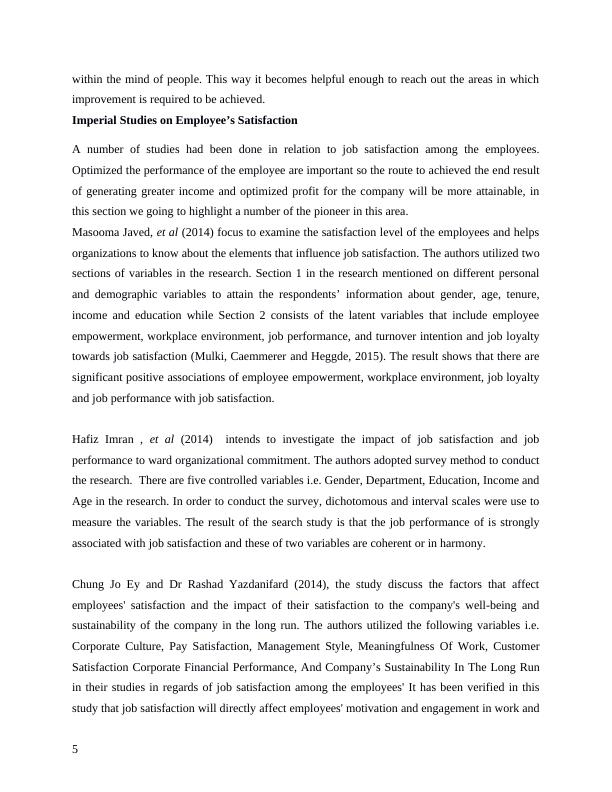
tend to link with customers' satisfaction, corporation's financial performance and sustainability,
in other word, profit.
determine the role of job satisfaction and commitment on job performance. There four affective
factors that includes organization, environment, the nature of the work and individual factor use
by authors in their research paper. The result of their research is that Kano model was used to
test the hierarchical correlation analysis of the hypotheses (Mafini and Dlodlo, 2014). Based on
the results, Pearson correlation coefficient was significant between job satisfaction and job
commitment at 99% that shows direct and strong correlation between two measures and means
that job commitment will increase by an increment in job satisfaction. The hypothetical impact
of job satisfaction and career Commitment on job performance was approved and Kano model
parameters are determined the factors that increase employee satisfaction.
Alamdar Hussain Khan, et al (2012) conducted research factors that influence level of job
satisfaction among the workforce and its effects on performance. The author using sampling
technique (questionaire) to collect data from Respondent. The questionnaire divided into two
parts, which the first section included the questions about pay, promotion, job safety and
security, working conditions, autonomy, relationship with co-workers, relationship with
supervisor and nature of work. The second part however focus on enumerate the demographic
factors like age, designation, education, experience, gender, job relevancy and nature of job
(Wong and Laschinger, 2013). The result of the research is that facet of job satisfaction such as
pay, promotion, job safety and security, working conditions, job autonomy, relationship with co-
workers, and relationship with supervisor, and nature of the work significantly affect the level of
job satisfaction.
Imperial Studies on Employee’s Psychological Ownership.
A number of studies had been done in relation to psychological ownership among the employees.
Optimized the performance of the employee are important so the route to achieved the end result
of generating greater income and optimized profit for the company will be more attainable, , in
this section we going shed some light on a number of the pioneer in this field .
Samsinar Md-Sidin , et al (2014) research paper focus on investigation of the impact of
psychological ownership, job performance, job commitment, and job satisfaction. The authors
6
in other word, profit.
determine the role of job satisfaction and commitment on job performance. There four affective
factors that includes organization, environment, the nature of the work and individual factor use
by authors in their research paper. The result of their research is that Kano model was used to
test the hierarchical correlation analysis of the hypotheses (Mafini and Dlodlo, 2014). Based on
the results, Pearson correlation coefficient was significant between job satisfaction and job
commitment at 99% that shows direct and strong correlation between two measures and means
that job commitment will increase by an increment in job satisfaction. The hypothetical impact
of job satisfaction and career Commitment on job performance was approved and Kano model
parameters are determined the factors that increase employee satisfaction.
Alamdar Hussain Khan, et al (2012) conducted research factors that influence level of job
satisfaction among the workforce and its effects on performance. The author using sampling
technique (questionaire) to collect data from Respondent. The questionnaire divided into two
parts, which the first section included the questions about pay, promotion, job safety and
security, working conditions, autonomy, relationship with co-workers, relationship with
supervisor and nature of work. The second part however focus on enumerate the demographic
factors like age, designation, education, experience, gender, job relevancy and nature of job
(Wong and Laschinger, 2013). The result of the research is that facet of job satisfaction such as
pay, promotion, job safety and security, working conditions, job autonomy, relationship with co-
workers, and relationship with supervisor, and nature of the work significantly affect the level of
job satisfaction.
Imperial Studies on Employee’s Psychological Ownership.
A number of studies had been done in relation to psychological ownership among the employees.
Optimized the performance of the employee are important so the route to achieved the end result
of generating greater income and optimized profit for the company will be more attainable, , in
this section we going shed some light on a number of the pioneer in this field .
Samsinar Md-Sidin , et al (2014) research paper focus on investigation of the impact of
psychological ownership, job performance, job commitment, and job satisfaction. The authors
6
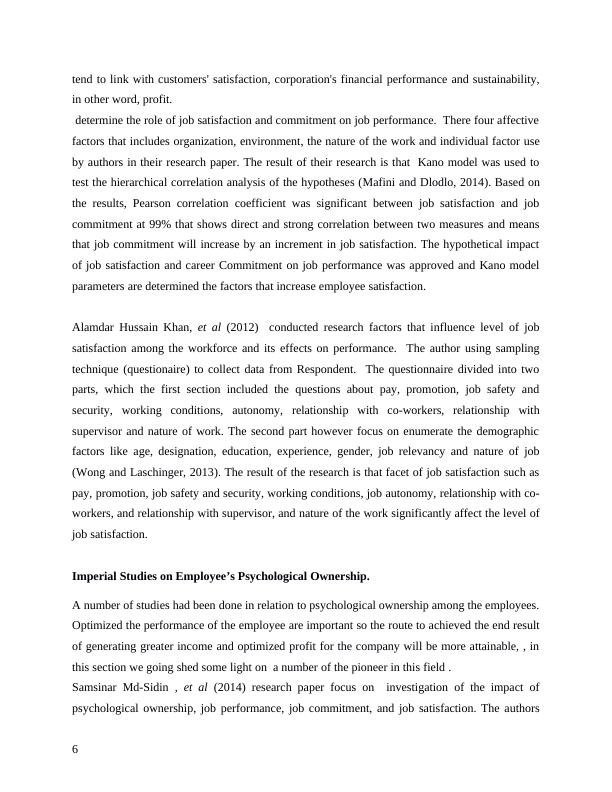
identify three factors that create psychological ownership among Respondent: (a) having control
over the target or object, (b) intimate contact or knowledge about the target or object, and (c)
investing the self to the target or object The result empirically shown that psychological
ownership has positive relations with job commitment, job satisfaction, and the three dimensions
of performance.
Divya K P.T.Srinivasan (2015) conducted to study is an attempt to build on the emerging theory
of psychological ownership, which has been developed over the last two decades and suggest the
scope for research on the influence work environment, psychological ownership and individual
work outcomes, The authors identify the following i.e efficacy and reflectance, self–identity and
having a place to dwell that create psychological ownership among Respondent (Knapp, Smith
and Sprinkle, 2014). The study has found that psychological ownership is an effective
managerial construct with significant practical implications for management.
Xie Qian (2016), the article reviews the latest research on psychological ownership from the
following three aspects: 1) theoretical background of psychological ownership; 2) connotation
and measurement of psychological ownership; 3) formation mechanism and influence
mechanism of psychological Ownership and also reveals the formation mechanism, the impact
mechanism and interpretation of psychological ownership from local organization members’
perspective under Chinese culture. The authors utilized the following variables i.e. Corporate
Culture, Pay Satisfaction, Management Style, Meaningfulness Of Work, Customer Satisfaction
Corporate Financial Performance, And Company’s Sustainability In The Long Run in their
studies in regards of job satisfaction among the employees' It has been verified in this study that
the impact boundary conditions of psychological ownership, especially what factors affect the
mediating role in the relationship between formal ownership and psychological ownership, need
further study.
Kimbal Fraser and Simon Kemp (2012),This study examines how psychological ownership by
employees of an organisation and their perceptions of justice might be affected by the actual
control they have over the organisation and the extent to which their remuneration depends on
the organisation’s performance. In the research there are 4 scenario use in conducting the
7
over the target or object, (b) intimate contact or knowledge about the target or object, and (c)
investing the self to the target or object The result empirically shown that psychological
ownership has positive relations with job commitment, job satisfaction, and the three dimensions
of performance.
Divya K P.T.Srinivasan (2015) conducted to study is an attempt to build on the emerging theory
of psychological ownership, which has been developed over the last two decades and suggest the
scope for research on the influence work environment, psychological ownership and individual
work outcomes, The authors identify the following i.e efficacy and reflectance, self–identity and
having a place to dwell that create psychological ownership among Respondent (Knapp, Smith
and Sprinkle, 2014). The study has found that psychological ownership is an effective
managerial construct with significant practical implications for management.
Xie Qian (2016), the article reviews the latest research on psychological ownership from the
following three aspects: 1) theoretical background of psychological ownership; 2) connotation
and measurement of psychological ownership; 3) formation mechanism and influence
mechanism of psychological Ownership and also reveals the formation mechanism, the impact
mechanism and interpretation of psychological ownership from local organization members’
perspective under Chinese culture. The authors utilized the following variables i.e. Corporate
Culture, Pay Satisfaction, Management Style, Meaningfulness Of Work, Customer Satisfaction
Corporate Financial Performance, And Company’s Sustainability In The Long Run in their
studies in regards of job satisfaction among the employees' It has been verified in this study that
the impact boundary conditions of psychological ownership, especially what factors affect the
mediating role in the relationship between formal ownership and psychological ownership, need
further study.
Kimbal Fraser and Simon Kemp (2012),This study examines how psychological ownership by
employees of an organisation and their perceptions of justice might be affected by the actual
control they have over the organisation and the extent to which their remuneration depends on
the organisation’s performance. In the research there are 4 scenario use in conducting the
7

research. There is as follows, Employment scenario, Share Trust scenario, Representative
Control scenario, Direct Control scenario (Hanus and Fox, 2015). The result of their research is
that both governance and operational control enhance psychological ownership and have
reasonably sized effects on commitment, perceived justice and satisfaction.
Mona Mohamed Sayed Ibrahim (2016) conducted research factors that influence level of job
satisfaction among the workforce and its effects on performance. The psychological ownership
emphasized that self-efficacy, self-identity, belonging, and accountability. The results of the
research is that increasing individual’s perceptions of organizational justice and enhance ethical
leadership and other types of leadership, organizations can increase individual’s psychological
ownership through developing its four dimensions.
1.1 Employee satisfaction (Common Variables).
A measurement of an employee’s “happiness” with current job and conditions; it does not
measure how much effort the employee is willing to expend. Job satisfaction is the
favourableness or un-favourableness with which employees view their work. As with motivation,
it is affected by the environment. Job satisfaction is impacted by job design. Jobs that are rich in
positive behavioural elements- such as autonomy, task identity, task significance and feedback
contribute to employee’s satisfaction. Fallowing these points come under this category:
Job design
Task identity
Recognition
Responsibility
Empowerment
Quantity of task.
Difficult level of task
8
Control scenario, Direct Control scenario (Hanus and Fox, 2015). The result of their research is
that both governance and operational control enhance psychological ownership and have
reasonably sized effects on commitment, perceived justice and satisfaction.
Mona Mohamed Sayed Ibrahim (2016) conducted research factors that influence level of job
satisfaction among the workforce and its effects on performance. The psychological ownership
emphasized that self-efficacy, self-identity, belonging, and accountability. The results of the
research is that increasing individual’s perceptions of organizational justice and enhance ethical
leadership and other types of leadership, organizations can increase individual’s psychological
ownership through developing its four dimensions.
1.1 Employee satisfaction (Common Variables).
A measurement of an employee’s “happiness” with current job and conditions; it does not
measure how much effort the employee is willing to expend. Job satisfaction is the
favourableness or un-favourableness with which employees view their work. As with motivation,
it is affected by the environment. Job satisfaction is impacted by job design. Jobs that are rich in
positive behavioural elements- such as autonomy, task identity, task significance and feedback
contribute to employee’s satisfaction. Fallowing these points come under this category:
Job design
Task identity
Recognition
Responsibility
Empowerment
Quantity of task.
Difficult level of task
8
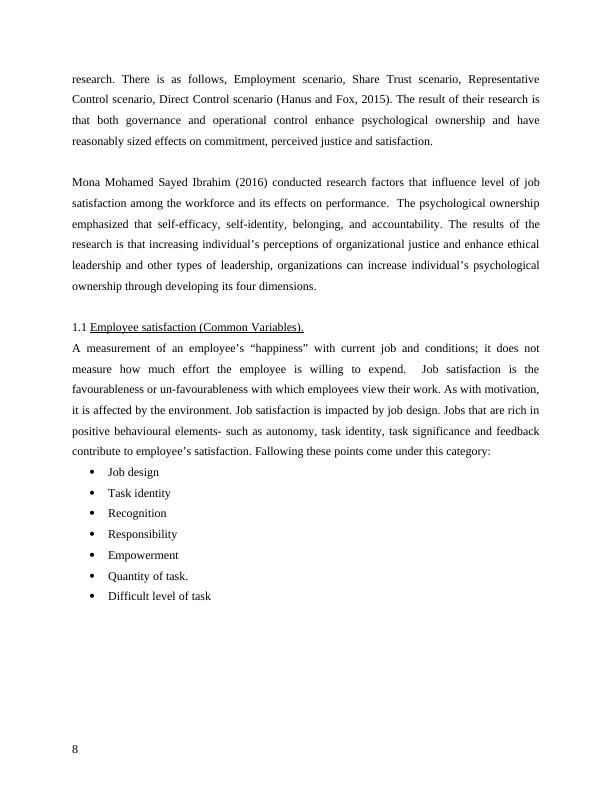
End of preview
Want to access all the pages? Upload your documents or become a member.
Related Documents
An Investigation of Job Satisfaction Impacts on Employeelg...
|53
|21826
|36
Impact on Employee Retention PDFlg...
|98
|18225
|53
Impact of recruitment strategies on employee retention - An overview of Eltizam Asset Management Group, UAElg...
|58
|13545
|77
MBA Project Dissertation 2022lg...
|64
|20487
|26
The Importance of Digitalizing the Kitchen Systemlg...
|54
|18449
|38
STRM044 : Business Research Projectlg...
|70
|15996
|60
